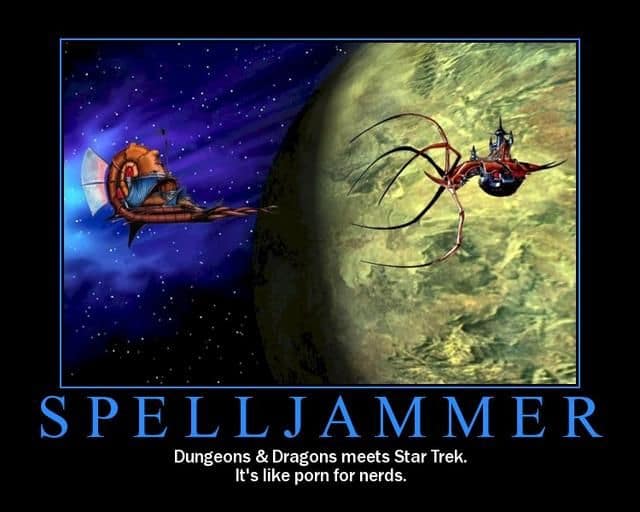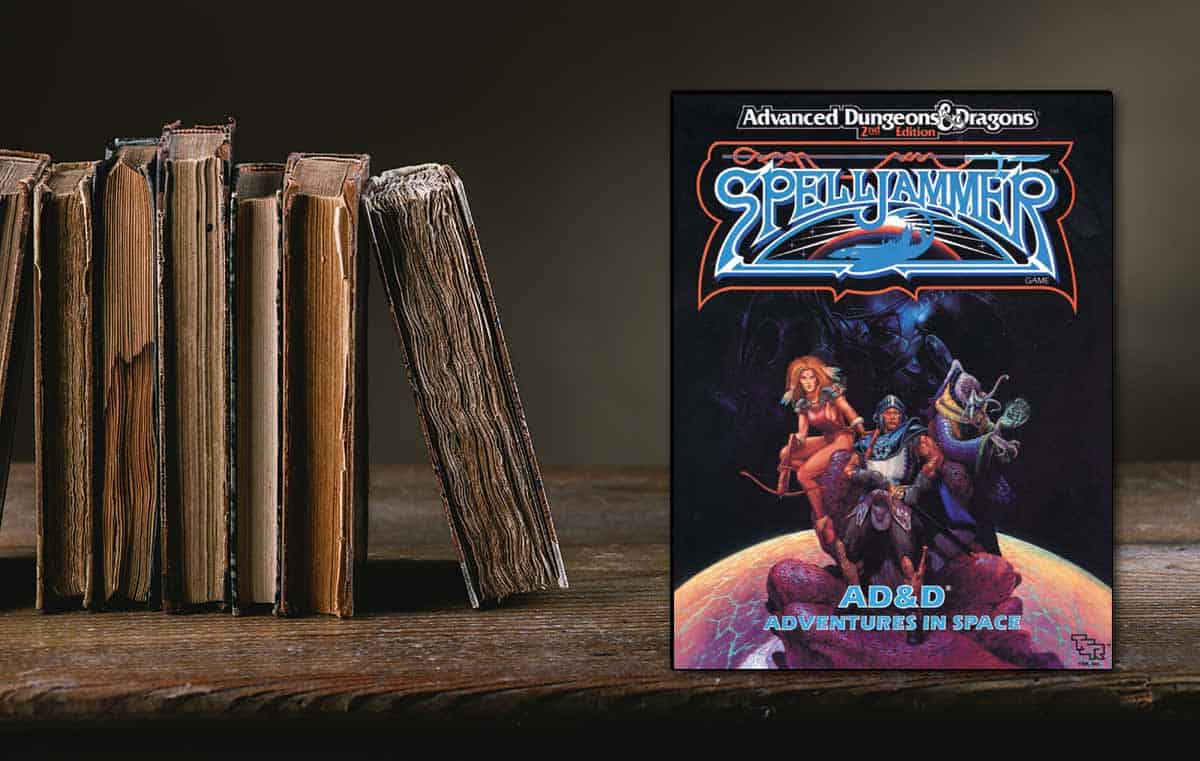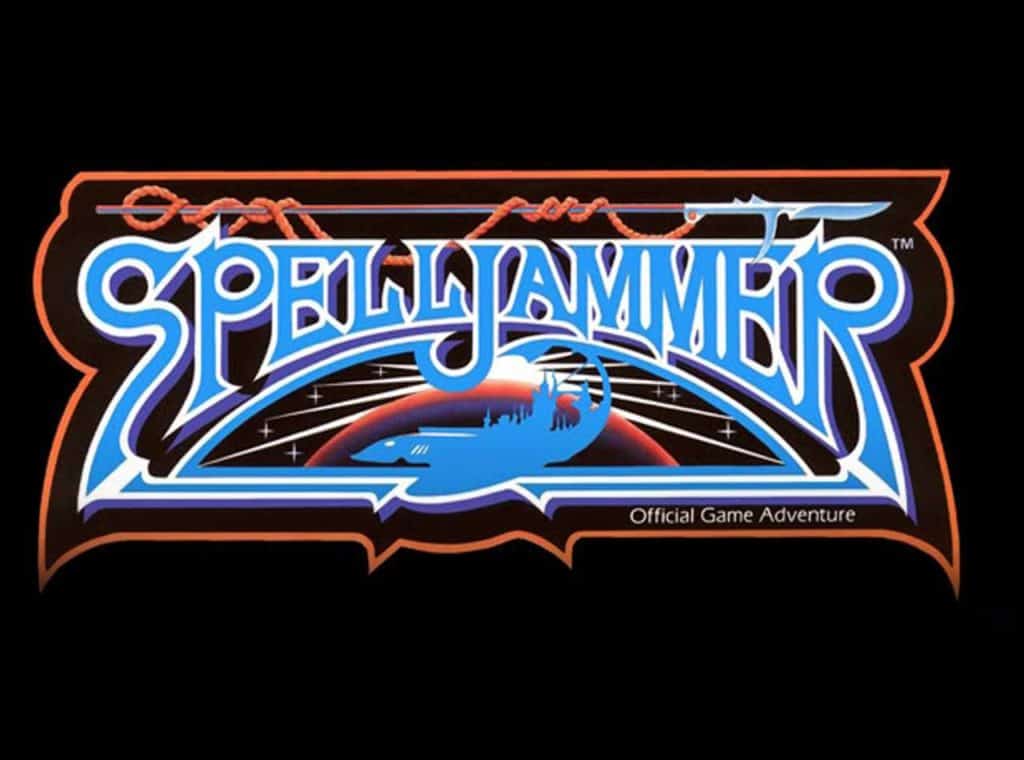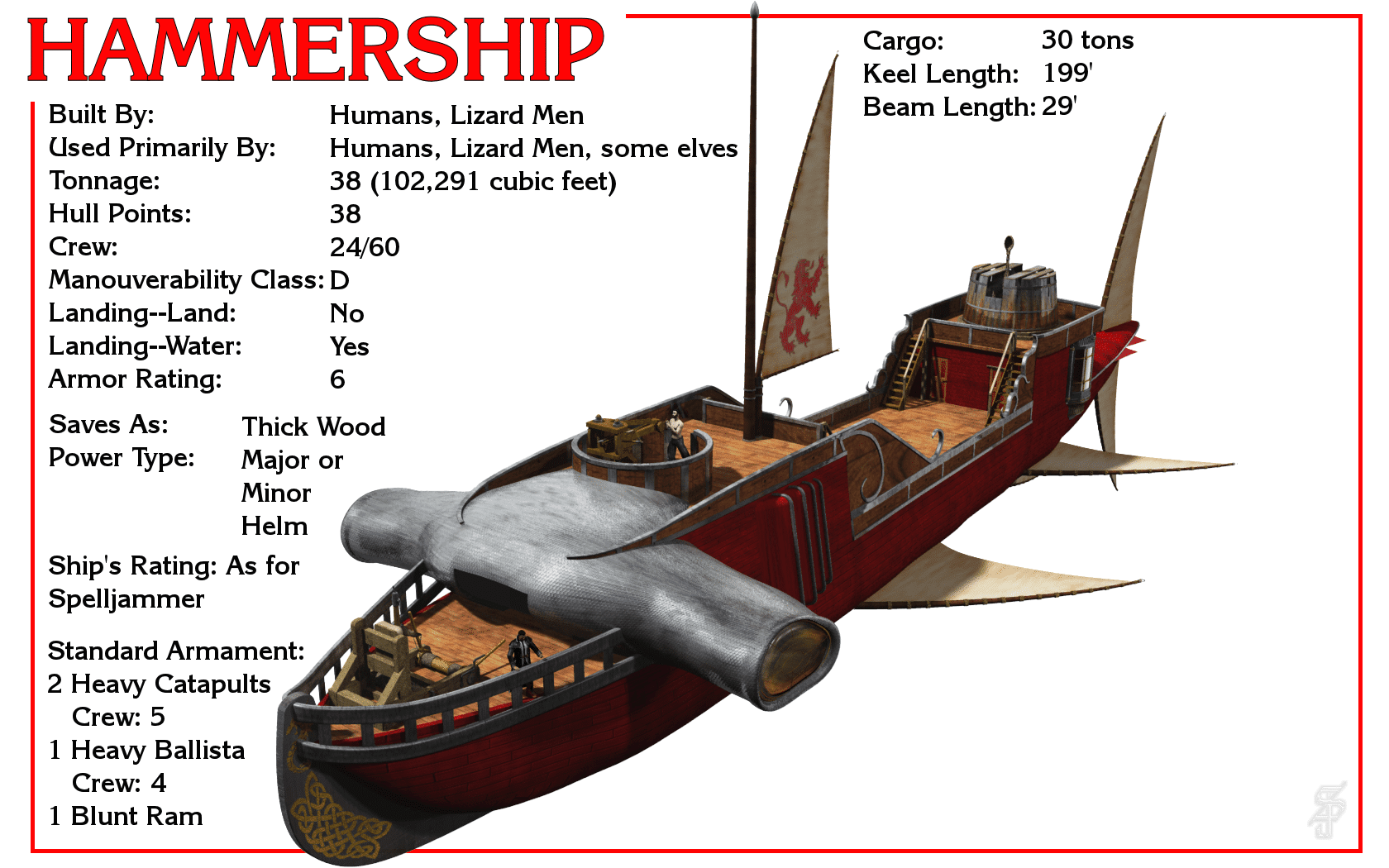At some point during its development, Dungeons and Dragons just got weird. It took a gamble on embracing every aspect of its cosmology and pushing out settings that seem incredibly odd to today’s players.
Fortunately, some of these settings ended up being spectacular. While they weren’t anything like the D&D players know and love today, they provided for fantastic worlds that still have strong fan bases.
One of the most beloved of these weird settings is Spelljammer. If you’ve ever wondered what it’d be like to take all of the cosmology information in Dungeons and Dragons and sail through those settings on a magical ship, you’ve probably got a great imagination. You’re probably also in the target audience for this game.
- Spelljammer Ships
- Spelljammer Races
- Advanced Dungeons & Dragons (2nd edition)
- Dungeons & Dragons (3rd edition)
- Spelljammer Novels
- Spelljammer Comics
- Future of Spelljammer?
Spelljammer Ships
At the heart of a traditional Dungeons and Dragons game is the party. At the heart of a Spelljammer game, though, is the ship. Spelljammer ships tend to be one part home base, one part character in most games. They’re easily the most valuable possession that any party can have and they’re the force by which players are able to interact with the universe around them.
In Spelljammer, virtually anything can be a ship. All it needs is a spelljamming helm. If a ship is equipped with the helm, a caster of any sort can sit on the helm and move the ship through the universe. As such, the ships can range from simple sailing ships to massive constructs, giving players a chance to create the exact ship of their dreams – or allowing DMs to create nightmares of their own fiendish design.
These ships can be far more than just a way to get around. In many campaigns, they serve as the plot impetus. Players might have to gather materials to repair the ship, deal with the possibility of having their ships stolen, or even have to take on contracts to afford spelljamming ships of their own. No matter what, though, the ship will be an important part of the game.
Spelljammer Races
As is traditional with the earlier Dungeons and Dragons settings, Spelljammer features both a handful of traditional D&D races and a number of its own unique denizens. What really separates out Spelljammer is that its unique races are incredibly weird. They just don’t work in a traditional setting, yet it’d be hard to imagine Spelljammer without them. The races of the setting include:
- Humans
- Dwarves
- Centaur: Not terribly smart, but fierce warriors. Typical half-horse demihumans.
- Dracon: Weird vegetarian dragon-centaurs.
- Elf
- Giff: Military-minded humanoids with hippo heads.
- Gnome
- Grommam: Gorilla-like humanoids.
- Hadozee: Mercenary apes who are close with the elves.
- Half-Elf
- Halfling
- Lizard Man: Exactly what it says on the tin.
- Rastipede: Weird kind of insect-centaur.
- Scro: A violent orc like race. Note that the name is just “Orcs” spelled backwards.
- Thri-keen: Space-faring insectoids.
- Wiggle: Also known as the Hurwaeti. More lizard people.
- Xixchil: Praying Mantis-like craftsmen.
In addition to the playable races, there are a fair number of creatures that inhabit the world of Spelljammer. Due to the nature of the setting, virtually anything that has ever appeared in another D&D setting can end up in the background of one of these games. Of special note here are Beholders, who make up the bulk of the more memorable antagonists of the game. It’s quite easy to take even a generic threat in another setting and give it a twist in Spelljammer.
Try my AI Tabletop RPG generators...and an extensive library of content!
Advanced Dungeons & Dragons (2nd edition)
As you might be able to tell from the strange setting and interconnected world, Spelljammer got its start in Advanced Dungeons and Dragons. AD&D was definitely a system that wasn’t afraid to experiment with how D&D could work and the vast number of settings released under the auspices of that title provided a great deal with which Spelljammer could work.
First released in 1989, Spelljammer was D&D’s nod towards space fantasy. It was released in a boxed set that not only provided the information for Spelljammer, but that also provided information for the realms of several other settings. These settings – Realmspace, Krynnspace, and Greyspace – allowed for Spelljammer to work with Forgotten Realms, Dragonlance, and Greyhawk.
⚔️ Fantasy RPG Random Tables Books
Make life as a Gamemaster easier…
If you play Dungeons & Dragons, Pathfinder, or other fantasy RPGs, this
RPG random tables series
is packed with encounters, NPCs, treasure, and more. Available in eBook or print—either way, you’ll have a wealth of adventure ideas at your fingertips.
Like most of the Second Edition settings, Spelljammer’s release was mostly confined to box sets. These sets started by providing basic rules, but then branched out to cover role playing campaigns and even ship-to-ship combat.
When TSR started moving towards handbooks instead of boxed sets, Spelljammer got its own set. This book largely covered how spelljamming travel worked, giving DMs a chance to better craft campaigns. This, in combination with a number of supplements, really fleshed out the entire Spelljammer universe into something special.
Dungeons & Dragons (3rd edition)
In the run-up to Third Edition, a number of the classic D&D settings started to be ignored. Spelljammer was one of the more unfortunate examples of this, as it still had a very strong player base and was considered one of the more imaginative settings. By the time that TSR sold the Dungeons and Dragons line to Wizards of the Coast, the setting was basically defunct.
Unfortunately, Wizards of the Coast didn’t show much love to Dungeons and Dragons’ varied settings in their initial publication run, choosing instead to focus on building the core Third Edition experience and streamlining the d20 rule set. As such, anything new for the Spelljammer world would come from outside sources.
In 2002, Paizo finally published an article about Spelljammer in Dragon Magazine. The article with unfortunately brief, simply providing rules for spelljamming and for firearms under the new d20 system. Much of what made Spelljammer so special, including its uniquely weird races, was left out. Instead, races from the Third Edition Monster’s Manual would be used with this basic rule set.
The formal life of Spelljammer might have been over in Third Edition, but the spirit lived on. There are dozens of examples of homebrew versions of Spelljammer available online that use the d20 rule set. Some are more successful than others, but they all show the love that fans had for Spelljammer.
Dungeons & Dragons (4th edition)
Unfortunately, Spelljammer did not have a triumphant comeback with Fourth Edition. While players may have hoped for some kind of major content update in light of all the homebrew attempts, but nothing was ever published. Spelljammer seemed dead as a separate line.
Fortunately, there was at least some official movement to bring back the concept of Spelljamming. Spelljamming was listed in the main line as a method of travelling between planes. Wizards of the Coast even provided information for how players could use a Spelljamming ship, though online in a very limited manner.
Once again, most of the Spelljammer work would fall to fans. There are many conversions out there for Fourth Edition, most of which simply expand upon what Wizards of the Coast wrote in the core books. There are a few full conversions out there imagining an updated version of Second Edition Spelljammer for a modern audience. Unfortunately, though, none of these products are official and many of them have become hard to find in the years since Fifth Edition was released.
With Fourth Edition, it became clear that the Spelljammer setting wouldn’t be updated any time soon. It was also clear, though, that the concepts of the setting were an important part of D&D. Instead of being a separate setting, Spelljammer has been absorbed into the main game.
Spelljammer Novels
Every setting worth talking about in Dungeons and Dragons has at least a few novels under its banner. While the Spelljammer novels were never as popular as the Dragonlance or Forgotten Realms, there was a decent audience for these books when they were released.
⚔️ Fantasy RPG Random Tables Books
Make life as a Gamemaster easier…
If you play Dungeons & Dragons, Pathfinder, or other fantasy RPGs, this
RPG random tables series
is packed with encounters, NPCs, treasure, and more. Available in eBook or print—either way, you’ll have a wealth of adventure ideas at your fingertips.
The Spelljammer line is relatively brief, spanning just over three years. There’s no single guiding voice for this line, which means that things can feel a bit disjointed moving from book to book. With this said, these books are some of the best examples of how creative one can get with the setting. If you’ve ever wanted to see how far Spelljammer could go, you owe it to yourself to read these books.
- Beyond the Moons by David Cook, (July, 1991): The first Spelljammer book. Introduces the character of Teldin Moore. A spelljamming ship crashes and a farmer receives a magical cloak. The first in the beginning of a trilogy. Generally well-received at the time, but has tended to get a fair bit more criticism as time has gone on. A good introduction to the setting for new players, if not necessarily a great book on its own merits.
- Into the Void by Nigel Findley, (October, 1991): Teldin Moore has escaped upon a spelljamming ship and he’s off to learn more about his magical cloak. At the same time, he and the cloak are both being hunted. While the book itself isn’t a terribly fun read, it does a better job of introducing the mechanics of the Spelljammer world than any of the source books. Come for the information, stay for the continuing adventures of a character to whom you will probably get attached.
- The Maelstrom’s Eye by Roger E. Moore, (May, 1992): The halfway point of the Cloakmaster Cycle. Teldin is still looking for information on his cloak, but now his search has put him at odds with the Scro and their mysterious enemy. This book draws Teldin closer to the mysteries of the Spelljammer itself. Another good book for those who want to learn more about the lore of the setting. It’s the only book that makes you wish it had been included in one of the early boxed sets.
- The Radiant Dragon by Elaine Cunningham, (November, 1992): Teldin is still looking for answers about his cloak. Along the way, he attempts to help a dragon take control of the Spelljammer. Very disjointed from the rest of the books in the series. Tends to seem like it is treading water even as it moves towards the end of the cycle. Probably the most negatively reviewed book in the series, despite the fact that it is reasonably well-written.
- The Broken Sphere by Nigel Findley, (May, 1993): Very much a rehash of what’s come before. Teldin goes to learn more about his cloak, gets betrayed, learns more about himself, and survives towards the end. Does get bonus points for feeling coherent, since the author had written a previous book in the series. The book finally feels like it progressing towards a real conclusion, which is good – it’s the second to last book in the series, after all. Honestly one of the better books in the entire cycle, all issues aside.
- The Ultimate Helm by Russ T. Howard, (September, 1993): The finale of the Cloakmaster Cycle and the Spelljammer novels. Teldin fights for control of the Spelljammer itself. Roundly considered both meandering and hurried, which is something of an accomplishment if you think about it. It did, however, really help to show how much had changed from the beginning of the cycle to the end. All in all, a fitting end to the cycle.
Spelljammer Comics
Spelljammer also had a comics series in the early nineties, running for only fifteen issues. The year and a half of published adventures did do some work to expand the universe, especially for those who were interested in the setting in the first place. One of the most notable aspects of the book was the fact that it used a Forgotten Realms character as one of its protagonists. While it might be easy to write this off as an attempt to make the book more popular among readers, it did help to show how connected all of the various realms of Dungeons and Dragons really were.
Spelljammer: Pirates of Realmspace
Spelljammer absolutely has legions of fans. It’s easily one of the most popular settings that Dungeons and Dragons ever had, even if has lost some of the limelight in recent years. There’s one thing that almost all of Spelljammer’s fans can agree on, though – this game absolutely never should have been made.
Spelljammer: Pirates of Realmspace is the only video game in the Spelljammer universe. It is by far the worst game in the Gold Box series, one of the worst games ever published by SSI, and possibly the worst game set in any D&D universe. If nothing else, that’s a major accomplishment for such a forgettable game.
The game was very much one of grinding reputation. Players would captain their own ship, take on simple missions, and trade goods between various planets. There was a greater plot, of course, but everything was really centered around combat. It was turn-based, as one might expect, but it did feature a unique ship boarding mechanic. While the game did push D&D combat forward, it still paled in comparison to almost everything else that was out there.
The game was a buggy mess, more of a headache than an entertainment product. The best thing that anyone could say about it was that the game had potential. Unfortunately, it was a potential that was squandered by a terrible video game.
Future of Spelljammer?
So, what does the future hold for Spelljammer? Unfortunately, it doesn’t look like the setting is coming back in an official way. It’s been largely ignored in Fifth Edition, but players around the world have kept diligently working on keeping the game alive. It only takes a few moments to find a reasonable Spelljammer conversion online and there are dozens of communities that have kept tweaking the lore of the setting. Spelljammer has always been a setting about exploration, so it only makes sense that players who love the setting should have to do a little bit of exploring to keep the game alive.













